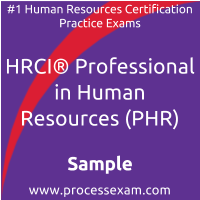01. Beth is a HR Professional for her organization and she's discussing the risk of growing her organization's business. What is risk and why would it be considered in HR for organizational growth?
a) Risk is an uncertain event or condition that may help or hinder an organization. Adding employees can help positive risks or amplify negative risk events.
b) Risk is an adverse event that can halt, hinder, or hurt the objectives of a business.
c) Risk is a negative event that an organization must consider when adding new employees to grow a company.
d) Risk is an uncertain event or condition that can have a positive or negative effect on the goals of an organization.
02. Mark is a HR Professional for his organization and he has been given the assignment to create an Affirmative Action Plan for his company. As Mark creates this document, which one of the following is not required to be in the Affirmative Action Plan?
a) Placement Goals
b) Job Group Analysis
c) Compliance Reviews
d) Designation of Responsibility
03. Your organization is using the whole job ranking technique as part of its non-quantitative job evaluation. Which one of the following best describes the whole job ranking technique?
a) Jobs are ranked from lowest to highest according to the importance that each job holds
b) Jobs are reviewed based on the entire performance of the organization in each category
c) Jobs are categorized into broad categories or levels
d) New jobs are categorized into an existing hierarchy of jobs within the organization
04. What act prohibits discrimination on the basis of physical and mental disabilities?
a) ADEA of 1967
b) Rehabilitation Act of 1973
c) VEVRAA of 1974
d) IRCA of 1986
05. You are a HR Professional for your organization and you're coaching Thomas on human resources practices, particularly the role of the HR Professional in strategic planning.
You tell Thomas the importance of vision, mission, and values of an organization. Thomas asks what the difference is between vision and mission.
Which one of the following best describes the difference between vision and mission for an organization?
a) A vision is the purpose of a company. A mission is the task the organization aims to accomplish
b) A vision describes the future of the organization while a mission describes the goals of the organization.
c) A vision describes the organization's role, what the organization is, and what the organization may aspire to be. A mission describes what the organization will definitely become.
d) A vision describes an organization's role, what the organization is, and what the organization wants to become. A mission describes the organization's purpose
06. Which of the following is the process of systematically determining a relative internal value of a job in an organization?
a) Broadbanding
b) Job evaluation
c) SWOT Analysis
d) Gainsharing
07. You are the HR Professional for your organization. You have just hired a new employee for your company. What form are you and the newly hired employee required to complete to show the employee's identity and eligibility to work in the United States?
a) IRCA-00
b) 1099
c) IRCA-86
d) I-9
08. Mathematical forecasting is also known as quantitative forecasting. Which one of the following statements best describes mathematical forecasting techniques?
a) The predictor of future performance is risk analysis of possible outcomes
b) The best predictor of future performance is statistical analysis of past performance results
c) The best predictor of future performance is past performance
d) The best predictor of future performance is structured reviews of current performance
09. If a union wants to organize, it typically moves through five steps to the organizing process. Which step of union organization would require the union to collect at least 30 percent of signed authorization cards from employees?
a) Confirm interest
b) The campaign
c) Make a connection
d) Obtain recognition
10. As an HR Professional you must address risk in the work place. There are two general categories of risk: pure risk and business risk. Which one of the following is an example of pure risk?
a) Loss of investment
b) Loss of life or limb
c) Safety training for workers in construction
d) Fines and penalties for breaking regulations
 You have to pass the PHR exam to receive the certification from HRCI. To increase the effectiveness of your study and make you familiar with the actual exam pattern, we have prepared this HRCI HR Professional sample questions. Our Sample HRCI Professional in Human Resources Practice Exam will give you more insight about both the type and the difficulty level of the questions on the HRCI HR Professional exam.
You have to pass the PHR exam to receive the certification from HRCI. To increase the effectiveness of your study and make you familiar with the actual exam pattern, we have prepared this HRCI HR Professional sample questions. Our Sample HRCI Professional in Human Resources Practice Exam will give you more insight about both the type and the difficulty level of the questions on the HRCI HR Professional exam.